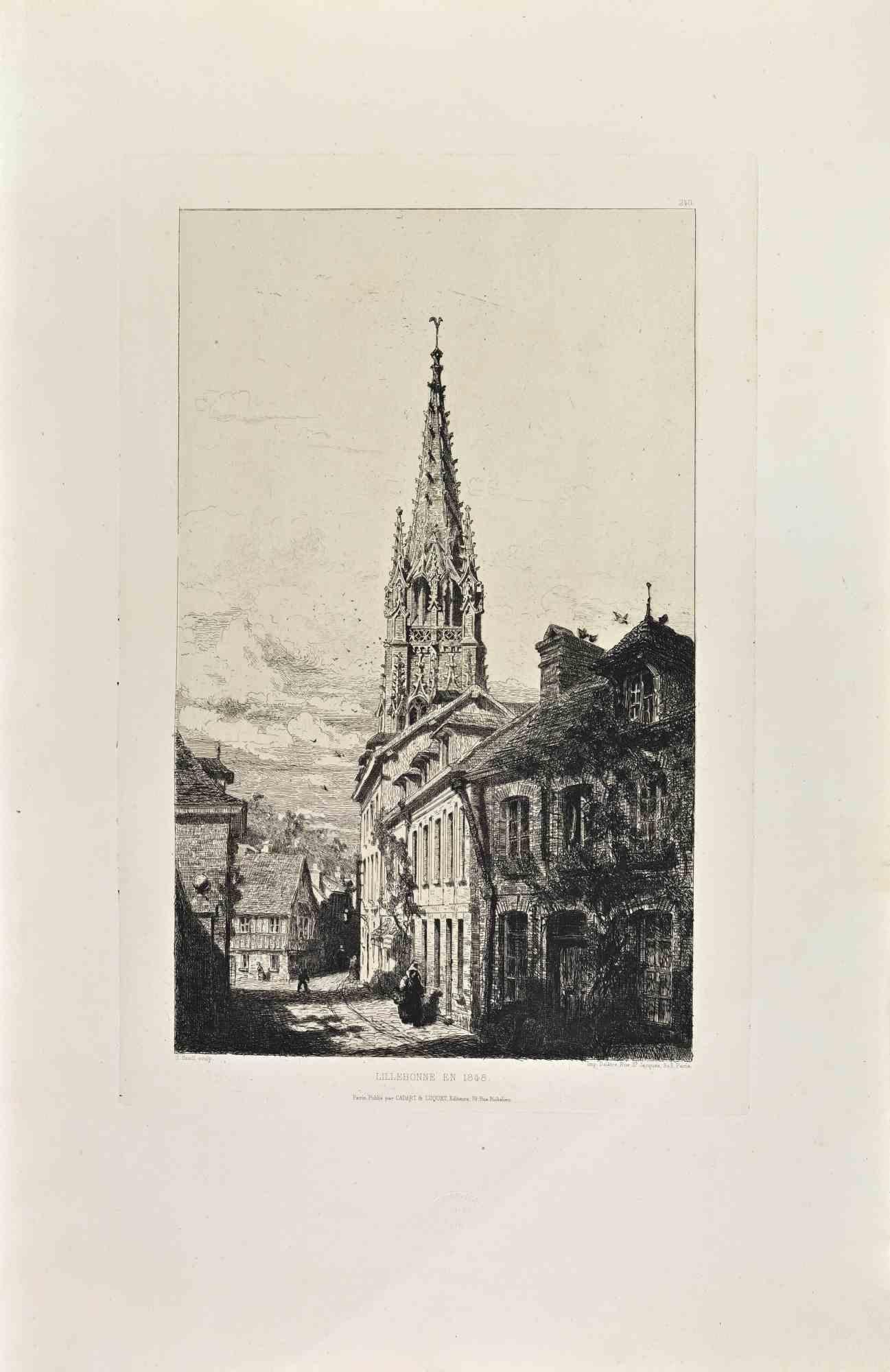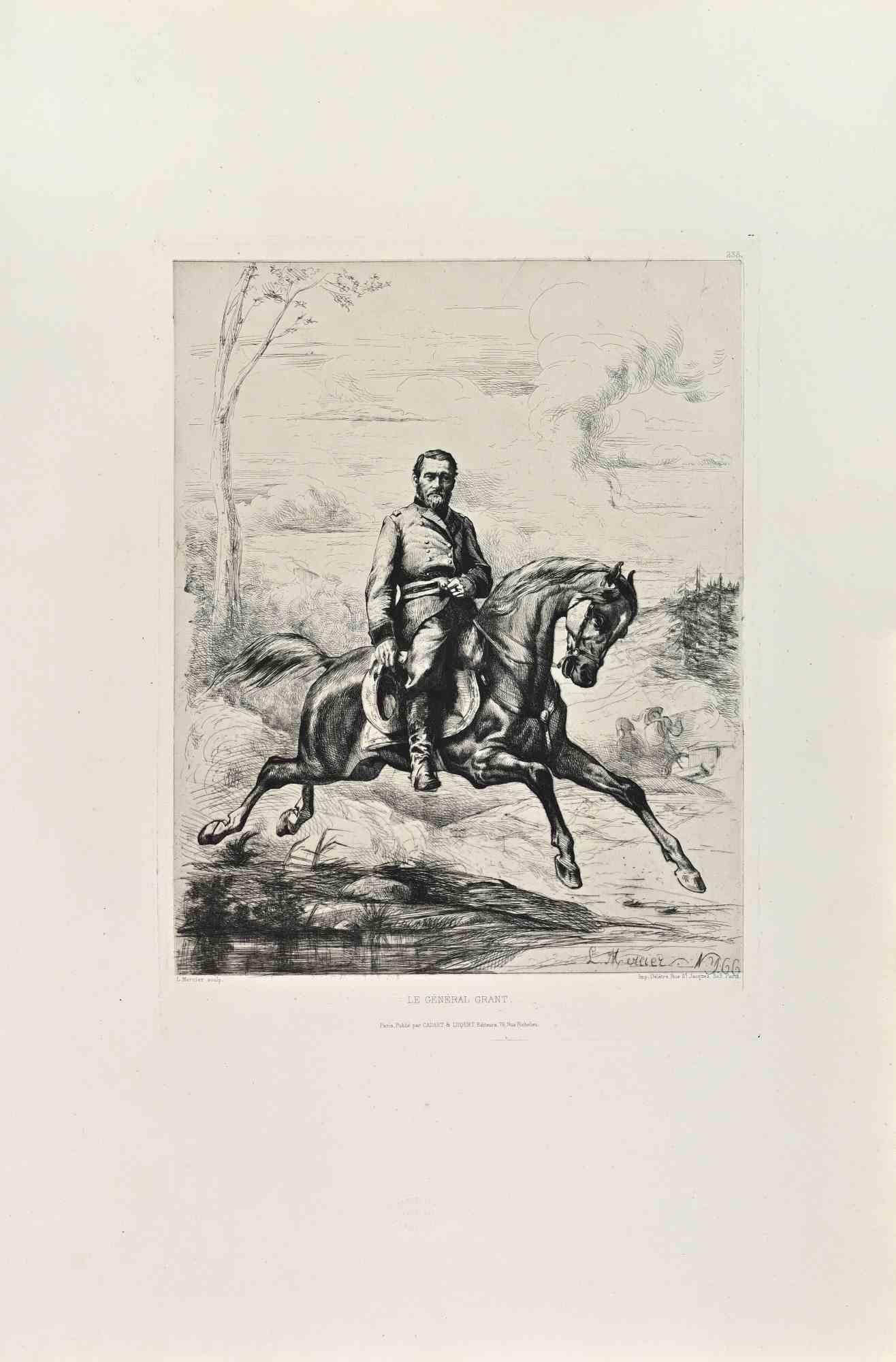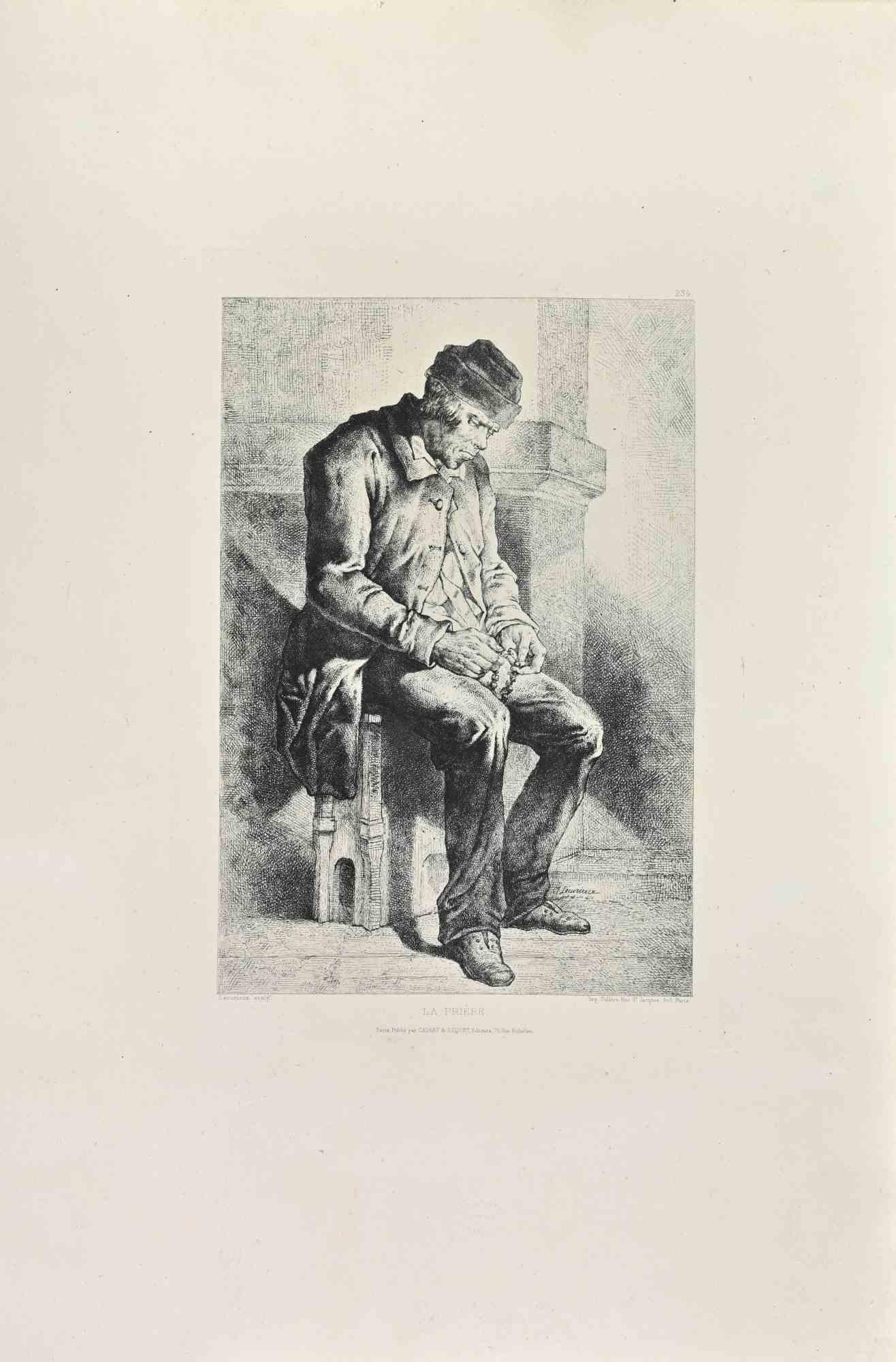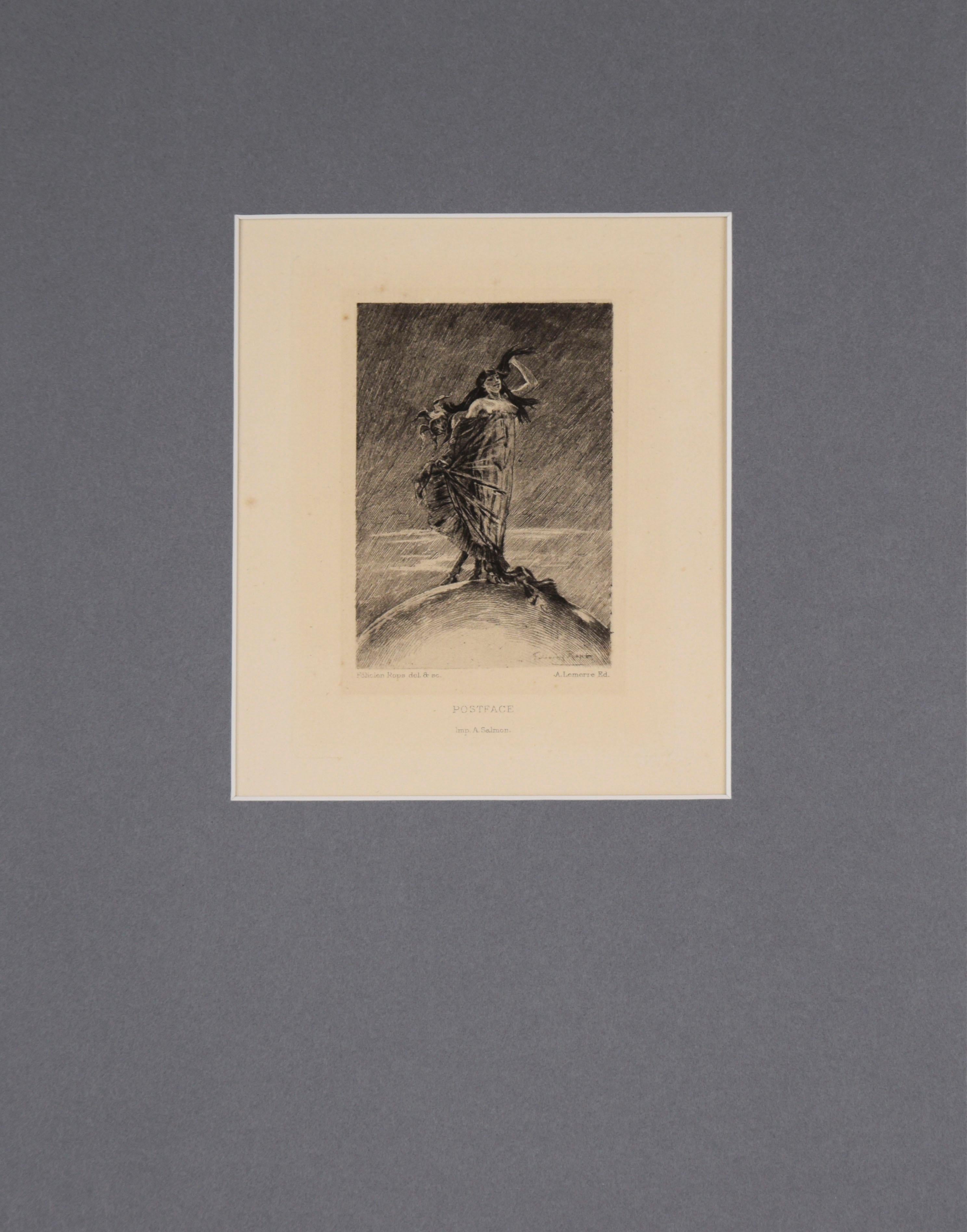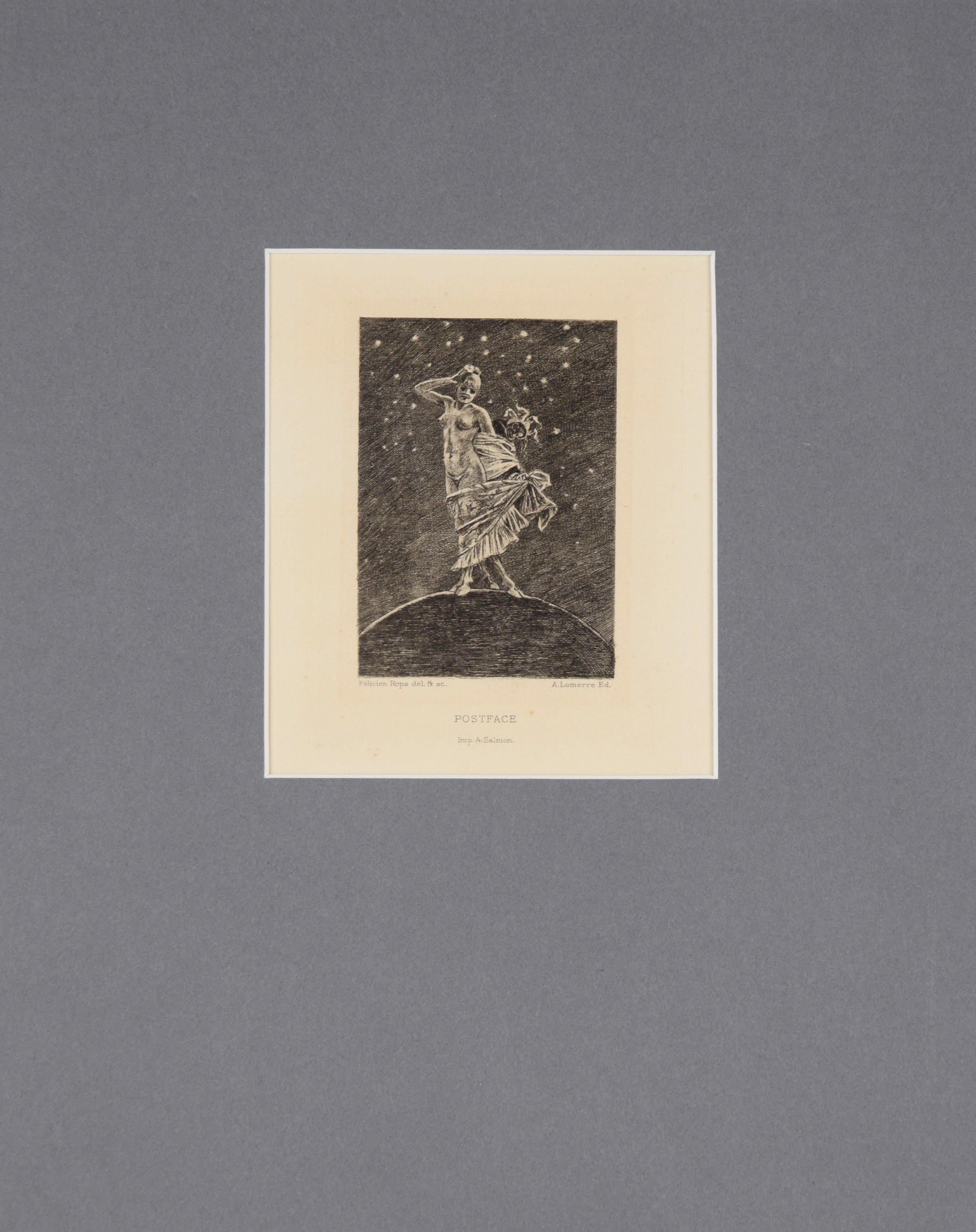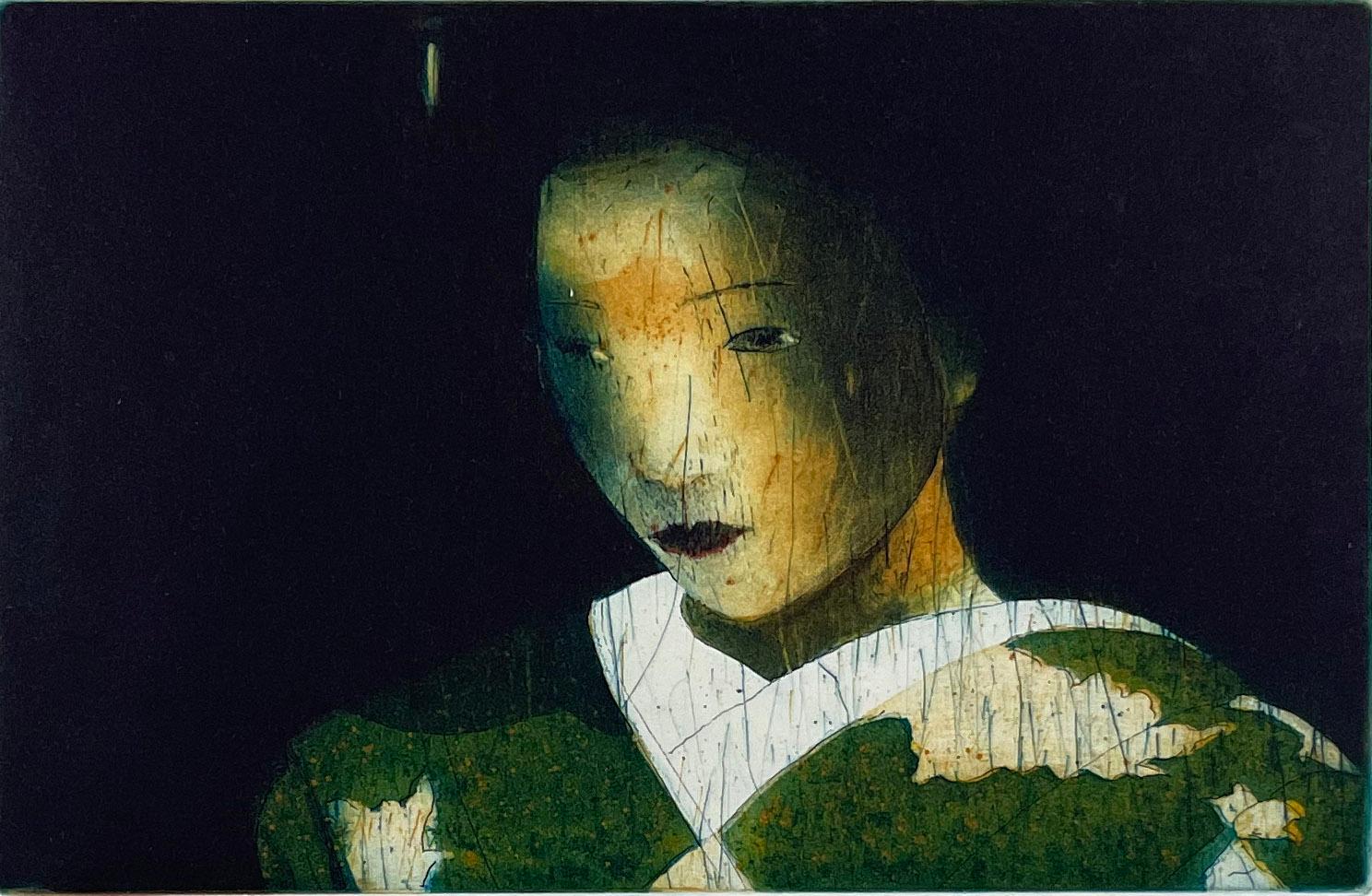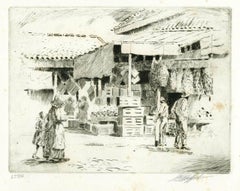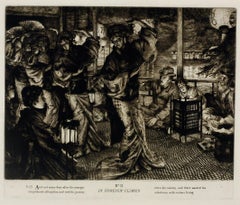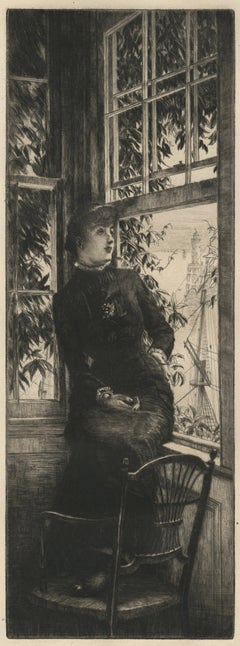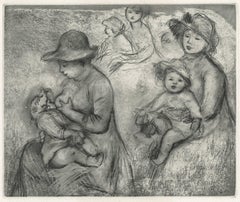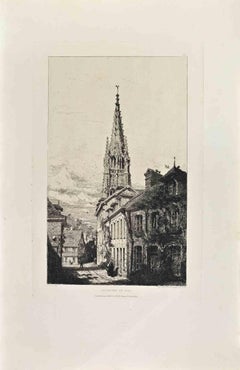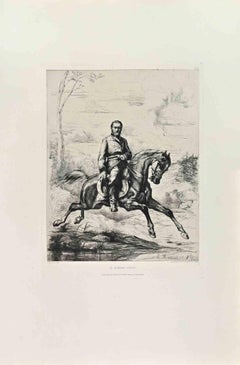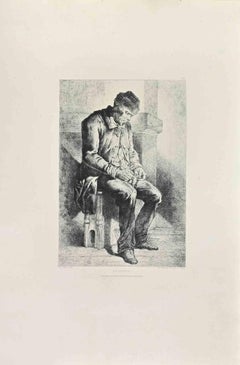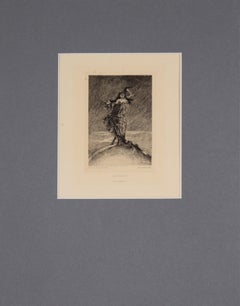Items Similar to La Terrasse de la Villa Brancas, Sevres (The Terrace of the Villa Brancas)
Want more images or videos?
Request additional images or videos from the seller
1 of 10
Félix BracquemondLa Terrasse de la Villa Brancas, Sevres (The Terrace of the Villa Brancas)1876
1876
About the Item
La Terrasse de la Villa Brancas, Sevres (The Terrace of the Villa Brancas)
etching & drypoint, 1876
Signed in the plate bottom right corner (see photo)
in plate, at lower left: xbre / 1876 [underlined]
A proof of State vii/VIII, before the addition of the inscription "L'Art" in the plate lower right corner. Very rare in any of the pre publication states
The etching depicts the terrasse of a villa overlooking the Seine valley, opposite the old factory and the heights of Bellevue.
"Bracquemond here represents his wife Marie painting her sister outdoors on the terrace of their villa at Sevres. The print was published in the periodical L'Art in 1879, the year that both Marie and Félix exhibited with the Impressionists." Courtesy MMA
Condition: Very good
Some staining consistent with being a working proof impression, prior to the published state
Image size: 10 1/16 x 13 15/16 inches
Sheet (irregular) 11 3/16 x 15 inches
Reference:
Beraldi 215, between vii and viii, prior to the inscription "L'Art" in the plate
IFF iii.381.377
"French engraver, painter, and decorator of ceramics. He is best known for his many etchings, both original and reproductions of famous paintings. Bracquemond was a chief founder of the influential Society of Painter-Engravers, established in France in 1889. Félix Bracquemond (1833 in Paris - 1914 in Sèvres) was a French impressionist painter and etcher. He was trained in early youth as a trade lithographer, until Guichard, a pupil of Ingres, took him to his studio. His portrait of his grandmother, painted by him at the age of nineteen, attracted Theophile Gautier's attention at the Salon. He applied himself to engraving and etching about 1853, and played a leading and brilliant part in the revival of the etcher's art in France. Altogether he produced over eight hundred plates, comprising portraits, landscapes, scenes of contemporary life, and bird-studies, besides numerous interpretations of other artist's paintings, especially those of Jean-Louis-Ernest Meissonier, Gustave Moreau and Jean-Baptiste Camille Corot. After having been attached to the Sèvres porcelain factory in 1870, he accepted a post as art manager of the Paris atelier of the firm of Haviland of Limoges. He was connected by a link of firm friendship with Édouard Manet, James McNeill Whistler, and all the other fighters in the impressionist cause, and received all the honors that await the successful artist in France, including the grade of officer of the Legion of Honor in 1889."
Courtesy Barnett Gallery
"In 1874, French printmaker Félix Bracquemond (1833-1914) submitted more works than any other artist to the inaugural impressionist exhibition. The work Bracquemond displayed—at his friend Edgar Degas’s invitation—included portraits of his artistic contemporaries, naturalistic landscapes, reproductive etchings of historical European paintings, and emblematic images of birds accompanied by poems (such as Margot the Critique, or The Magpie).
Bracquemond and each of the more than 50 members of the impressionist cooperative possessed varied aesthetic goals, sharing only a determination toward artistic independence from the State-sponsored annual Salon. Today, however, major exhibitions tend to pigeonhole Impressionism as landscapes and informal portraiture by select artists, namely Claude Monet, Pierre-Auguste Renoir, Berthe Morisot, and/or Camille Pissarro. Whether for that reason or the fact that Bracquemond himself did not identify closely with the label “impressionist,” the artist’s work is often not considered alongside that of his impressionist contemporaries. The special exhibition Félix Bracquemond: Impressionist Innovator (on view Feb 14 –Oct 4, 2015) reintroduces this independent-minded artist through a selection of more than eighty works on paper and tableware objects, including his most imaginative and groundbreaking reinterpretations of French art and decorative arts traditions.
Plate (Rooster, Frog, and Flower) from the Service Rousseau, 1866-76, Félix Bracquemond, glazed earthenware, Gift of Frank Raysor, 2013.506
“Plate (Rooster, Frog, and Flower)” from the Service Rousseau, 1866-76, Félix Bracquemond, glazed earthenware, Gift of Frank Raysor, 2013.506
After learning etching through self-directed study, Bracquemond emerged as a leader of the Etching Revival in France. In 1863, he co-founded the Société des Aquafortistes (Society of Etchers) with enterprising publisher Alfred Cadart and fellow printmakers, whose goal was to rekindle interest in original etchings among artists and the public alike. VMFA’s exhibition includes a frontispiece that Bracquemond produced for one of the group’s albums—portfolios made available by subscription—as well as original compositions published by arts journal that promoted these experimental “painter-printmakers.”
Bracquemond’s distinctive bird imagery—well-represented in the exhibition—often reflects his taste for Japanese art. A pioneer of Japanese-inspired compositions who had procured a volume of Hokusai’s Manga (translated as “Random Sketches”) as early as 1856, Bracquemond next built his reputation as a decorative arts innovator by infusing ceramic designs with motifs adapted from Japanese print sources. The Service Rousseau, which features birds, fish, insects, and flowers that he borrowed from Manga, helped propel the popularity of Japonisme throughout France. Bracquemond briefly served as artistic director at Sèvres porcelain factory before assuming that role for Haviland Limoges porcelain manufactory until 1881. Despite these successful forays into ceramics, Bracquemond remained dedicated to exploring the vast aesthetic possibilities of the print making process into the early 20th century."
Courtesy VMFA
- Creator:Félix Bracquemond (1883 - 1914, French)
- Creation Year:1876
- Dimensions:Height: 10.07 in (25.58 cm)Width: 13.94 in (35.41 cm)
- Medium:
- Movement & Style:
- Period:
- Condition:
- Gallery Location:Fairlawn, OH
- Reference Number:Seller: FA109541stDibs: LU14014663622
Félix Bracquemond
Fe´lix Bracquemond was born in Paris. He was trained in early youth as a trade lithographer, until Guichard, a pupil of Ingres, took him to his studio. His portrait of his grandmother, painted by him at the age of nineteen, attracted The´ophile Gautier's attention at the Salon. He applied himself to engraving and etching about 1853, and played a leading and brilliant part in the revival of the etcher's art in France. Altogether he produced over eight hundred plates, comprising portraits, landscapes, scenes of contemporary life, and bird-studies, besides numerous interpretations of other artist's paintings, especially those of Jean-Louis-Ernest Meissonier, Gustave Moreau and Jean-Baptiste-Camille Corot. After having been attached to the Se`vres porcelain factory in 1870, he accepted a post as art manager of the Paris atelier of the firm of Haviland of Limoges. He was connected by a link of firm friendship with E´douard Manet, James McNeill Whistler, and all the other fighters in the impressionist cause, and received all the honors that await the successful artist in France, including the grade of Officer of the Legion of Honor in 1889. Bracquemond was a prominent figure in artistic and literary circles in the second half of the 19th century. He was close to writers such as Edmond de Goncourt and critic Gustave Geffroy, and numbered among his friends Millet and Corot, Henri Fantin-Latour, Degas and the Impressionist circle, and Auguste Rodin. He was one of the more prolific printmakers of his time and he was awarded the grande medaille d'honneur at the Universal Exhibition of 1900. He was also a painter, ceramist, and an innovator in decorative arts. Gabriel Weisberg called him the "molder of artistic taste in his time". Indeed, it was he who recognised the beauty of the Hokusai woodcuts used as packing around a shipment of Japanese china, a discovery which helped change the look of late 19th-century art. He married French Impressionist artist Marie Bracquemond in 1869. He died in Se`vres.
About the Seller
5.0
Recognized Seller
These prestigious sellers are industry leaders and represent the highest echelon for item quality and design.
Platinum Seller
Premium sellers with a 4.7+ rating and 24-hour response times
Established in 1978
1stDibs seller since 2013
784 sales on 1stDibs
Typical response time: 1 hour
Associations
International Fine Print Dealers Association
- ShippingRetrieving quote...Shipping from: Akron, OH
- Return Policy
Authenticity Guarantee
In the unlikely event there’s an issue with an item’s authenticity, contact us within 1 year for a full refund. DetailsMoney-Back Guarantee
If your item is not as described, is damaged in transit, or does not arrive, contact us within 7 days for a full refund. Details24-Hour Cancellation
You have a 24-hour grace period in which to reconsider your purchase, with no questions asked.Vetted Professional Sellers
Our world-class sellers must adhere to strict standards for service and quality, maintaining the integrity of our listings.Price-Match Guarantee
If you find that a seller listed the same item for a lower price elsewhere, we’ll match it.Trusted Global Delivery
Our best-in-class carrier network provides specialized shipping options worldwide, including custom delivery.More From This Seller
View AllNoon Time Lull (Charleston, South Carolina)
By Louis Oscar Griffith
Located in Fairlawn, OH
Noon Time Lull (Charleston, South Carolina)
Etching, c. 1930
Signed by the artist in pencil lower right (see photo)
Note: An image done in South Carolina.
An impression of this image...
Category
1930s American Impressionist Figurative Prints
Materials
Etching
L'enfant prodigue: en pays etranger (The Prodigal Son: In Foreign Climes)
By James Jacques Joseph Tissot
Located in Fairlawn, OH
L'enfant prodigue: en pays etranger (The Prodigal Son: In Foreign Climes)
Etching, 1881
Unsigned (as usual for this state)
From: L'enfant prodigue, (The Prodigal Son, five plates)
Ed...
Category
1880s Impressionist Figurative Prints
Materials
Etching
Au bord de la mer (At the Sea Side)
By James Jacques Joseph Tissot
Located in Fairlawn, OH
Au bord de la mer (At the Sea Side)
Etching and drypoint, 1880
Signed in the plate middle left edge (see photo)
Edition: c. 100
A very rich impression, full of burr and contrasts
Pri...
Category
1880s Impressionist Figurative Prints
Materials
Etching
Trois Esquisses de maternite (Three Studies of Maternity)
By Pierre Auguste Renoir
Located in Fairlawn, OH
After Pierre Auguste Renoir (1841-1919)
Trois Esquisses de maternite (Three Studies of Maternity)
Heliogravure with etching on velin paper, 1893
Unsigned as issued
Edition 1000, ther...
Category
1890s Impressionist Figurative Prints
Materials
Etching
L'enfant prodigue: en pays etranger (The Prodigal Son: In Foreign Climes)
By James Jacques Joseph Tissot
Located in Fairlawn, OH
L'enfant prodigue: en pays etranger (The Prodigal Son: In Foreign Climes)
Etching, 1881
Unsigned (as usual for this state)
From: L'enfant prodigue, (The Prodigal Son, five plates)
Ed...
Category
1880s Impressionist Figurative Prints
Materials
Etching
Le Gamin (The Kid)
By Édouard Manet
Located in Fairlawn, OH
Le Gamin (The Kid)
Etching on laid paper, 1862
Signed in the plate upper left (see photo)
As published in Theodore Duret, L'Histoire d'Edouard Manet et de Son Ouvre, 1902 (The first ...
Category
1860s Impressionist Figurative Prints
Materials
Etching
You May Also Like
Lillebonne en 1848 - Etching by George Snell - 1860s
Located in Roma, IT
Lillebonne en 1848 is a black and White etching realized by George Snell in the 1860s.
Titled in the lower.
Image size: 25x37.
Very good impression with wide margins and a very f...
Category
1860s Impressionist Figurative Prints
Materials
Etching
Le General Grant - Etching by Louis-Sébastien Mercier - 1860s
Located in Roma, IT
Le General Grant is a black and White etching realized by Louis-Sébastien Mercier in the 1860s.
Titled in the lower.
Image size: 32x24.
Very good impression with wide margins and...
Category
1860s Impressionist Figurative Prints
Materials
Etching
La Priere - Etching by Jacques-Joseph Lecurieux - 1860s
Located in Roma, IT
La Priere is a black and White etching realized by Jacques-Joseph Lecurieux in the 1860s.
Titled in the lower.
Image size: 31x23.
Very good impression with wide margins and a ver...
Category
1860s Impressionist Figurative Prints
Materials
Etching
"La Femme et la Folie Dominent le Monde II" - 1886 Print on Paper
By Félicien Rops
Located in Soquel, CA
"La Femme et la Folie Dominent le Monde II" - 1886 Print on Paper
("The Woman and the Madness Overlooking The World II")
1886 French illustration from Felicien Rops (Belgian, 1833-...
Category
1880s Impressionist Figurative Prints
Materials
Etching, Paper, Ink
"La Femme et la Folie Dominent le Monde I" - 1886 Print
By Félicien Rops
Located in Soquel, CA
"Postface. La Femme et la Folie Dominent le Monde I" (1886)
1886 French illustration from Felicien Rops (Belgian, 1833-1898) depicting a young partially nude woman. The woman is st...
Category
1880s Impressionist Figurative Prints
Materials
Paper, India Ink, Etching
Within the Moon, by Stephen Lawlor
Located in Palm Springs, CA
Medium: Aquatint, Drypoint, Etching
Year: 2017
Image Size: 7.9 x 5.25 inches
Edition Size: 75
Beautiful impressionist image a japanese woman in traditional Kimono.
Lawlor's early e...
Category
2010s Impressionist Portrait Prints
Materials
Etching, Aquatint
Recently Viewed
View AllMore Ways To Browse
French Sevres Plates
A L Limoges
Design De Limoges
Limoges Sevres
Antique Sevres Plates
Sevres Porcelain Limoge
Flower Frog
Old Tableware Service
Bird Sevres
Ceramic Insects
Frog Plates
Old Roosters
Sevres Porcelain Birds
Antique Haviland
Limoges France Service
Limoges Portrait
Japanese Rooster
Antique Japanese Bird Prints
